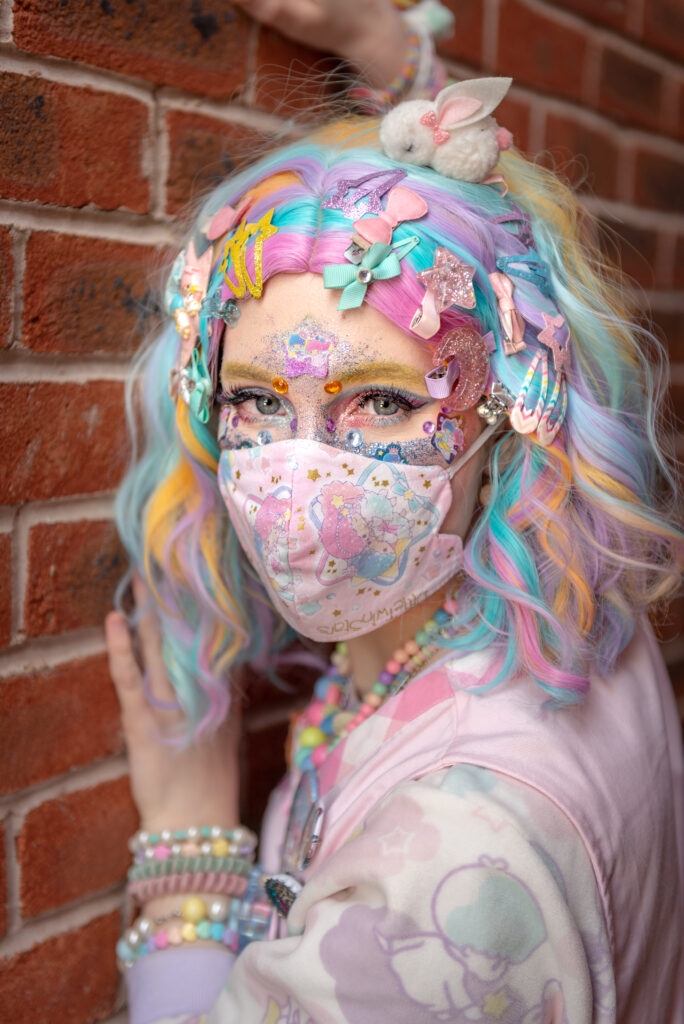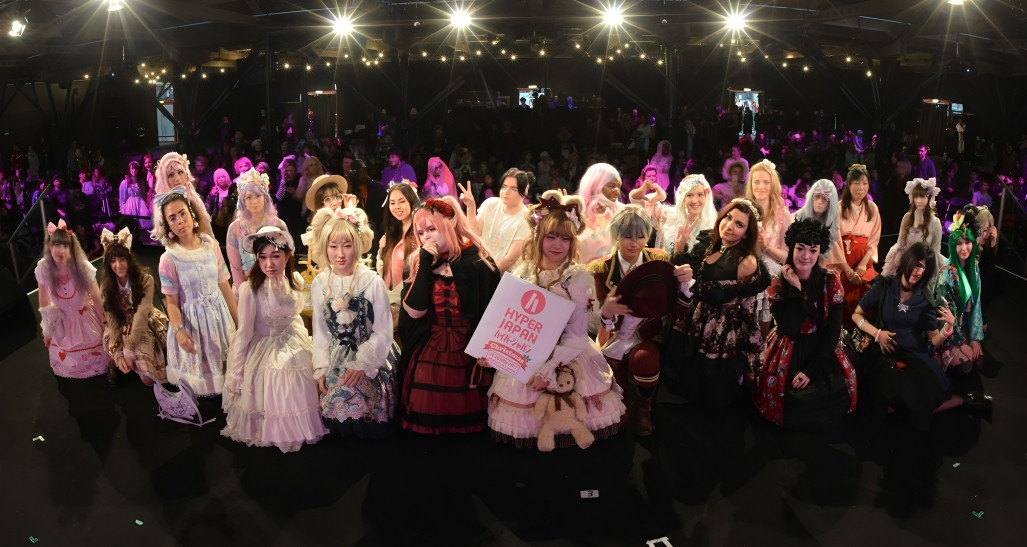This article originally appeared in the April 2024 issue of CONNECT.
Holly Walder (Gunma)
Japanese fashion has moved on, why then, had “J-fashion” not followed suit?
What comes to mind when you hear “J-fashion”? Literally the phrase means “Japanese fashion,” but as I learnt over the last decade of Japanophilia, it is not an umbrella term for Japanese fashion brands like Uniqlo and Mizuno, or even a reference to traditional kimono. J-fashion as a term refers more narrowly to styles that originated on the streets of Harajuku and Shibuya in the 90s and early 2000s, but now enjoy more popularity abroad than in Japan itself. (1)
My journey into J-fashion
When I was first introduced to the term “J-fashion” ten years ago, it was a reference to the popular images of girls in the frilly, demure Victorian-inspired style called “lolita fashion” that circulated the blogosphere. As a fourteen-year-old, British, anime-loving wannabe scene kid, the steep price tags and strict style conventions put me off trying lolita fashion myself, but it appealed to me to try experimenting with clothing that set me apart from my galaxy-pattern legging and moustache T-shirt wearing peers.

It wasn’t long before I discovered the other styles known as “J-fashion.” Most of the styles ended with the word kei, meaning “style” in Japanese. This is similar to the way Gen Z uses the “-core” suffix to describe particular aesthetics. (2) I considered the garish colours, clashing patterns, and bold plastic accessories of decora (3), then the glamorous androgyny of visual kei (4), before I settled on the pastel 80s pop fashion-inspired style fairy kei (5) (note: no relation to fairycore). (6) A few other styles, such as mori kei (7), Larme kei (which did not originate in Japan, but this will be addressed later), and yami kawaii (8) or “creepy cute,” were also featured.
A brief side note before anyone protests that I should be saying “kei fashion.” Indeed, most of what I discuss here could be called “kei fashion.” (9) However, the reasons I am not using this term for the article are because: kei fashion as a term is more heavily associated with visual kei and adjacent styles, J-fashion was and still is the most widely used term, and as I go on to argue, J-fashion is its own phenomenon that does not encompass all fashions that “kei fashion” does. Plus, when said out loud, it sounds like K-fashion, as in Korean fashion, which is a different thing, so I feel the phrase itself is too easily misunderstood to be useful. But I digress. . .
This is by no means an exhaustive list of styles that are considered J-fashion—and new styles are popping up in Japan all the time—but it was clear that at least in the British J-fashion community, lolita and fairy kei reigned supreme, and continue to do so even now. Wearing J-fashion does not mean dressing like the average Japanese person, but identifying with a narrow subset of fashion styles that were popular in Harajuku or Shibuya, mostly in the 90s and early 2000s.

At the age of 15 and 16, at the height of my J-fashion craze, I spent many hours browsing second-hand shops and squeezing past groups of pre-teens in Claire’s to fill out my wardrobe, occasionally saving up to splash out on UK-based independent creators and the iconic Japanese brands that appeared on clothing racks at Japan conventions like Hyper Japan to snag all the must have items and ideal silhouette. For me, much of my free time was about finding all the things that my peers and the girls on Google images suggested were absolute must-haves for fairy kei aficionados: the iconic tricolour Bodyline tutu, SPANK! Handmade accessories, Listen Flavour’s creepy-cute T-shirts, ACDC RAG jackets, and those pastel rainbow cardigans that everyone but me seemed to own in one variation or another. I even participated in a handful of fashion shows, and met many Instagram-famous personalities like Fifidoll (could list some more), and it was much the same; picture-perfect lolita dresses, and a smattering of gothic styles, neon decora and kimono dresses among a sea of pastel cuties.
Of course, my first priority when I visited Japan for the first time was raiding Harajuku for the clothes I had been dreaming about. In 2015 and 2016, there was a decent collection for fairy kei lovers. Bodyline still stocked its iconic tutu, ACDC RAG had no less than three shops along Takeshita Street, 6%DOKIDOKI was coming out with instant essential statement pieces, and WEGO had a great selection of pastel clothes and even a photoshoot area for enthusiasts to snap themselves in their outfits. But it has been nearly ten years since then, and while all these brands are still very much around, the popular fashion trends in Harajuku have moved on. Lolita is ever present—although with all its many substyles, it too is evolving—and the peak for fairy kei and decora fashion in Japan has long passed to make way for Jirai kei, (10) Peeps, (11) and other styles that still feature cutesy and gothic accessories, but in a more subtle way that deviates much less from the mainstream.
So what is J-fashion?
Japanese fashion has moved on, why then, had “J-fashion” not followed suit? The Fairy Kei UK community on Facebook is small but still very active with almost 1000 members, and the same faces appear wearing similar clothing each year in the fashion shows. There are several reasons for this. The first is that many of them are the same people, and everyone has their own individual style. While in Japan these trends were a brief phase for mainly teenagers and twenty-somethings, J-fashion is a long-term lifestyle for those who follow it in foreign countries. The other reason is that J-fashion is not a Japanese idea. All fashion worn in Japan by a Japanese person can be considered “Japanese fashion,” after all, so the subcultural styles encompassed by J-fashion might be called Harajuku or Shibuya style, but are more often referred to in Japan by their individual names.

J-fashion is its own phenomenon, and this is seen clearly in the styles of Larme kei and western Otome. Traditionally, Japanese subcultural styles are very defined around a particular aesthetic or brand, like lolita, decora, and so on. Classic Otome (12) was a style that appeared in the Olive and Pink House magazines in the 1970s that featured modest, refined clothing with girl twists like frills and bows and mismatching patterns. However, the term has since been appropriated by Western Lolita fans to refer to casual Lolita—a broad term that essentially describes wearing a lolita-style JSK (jumperskirt) with none of the expected accessories like petticoats and patterned tights (though some argue this should not be considered Lolita at all). It has almost no relation to the original Otome, except an emphasis on femininity and modesty. Like casual lolita, there is no petticoat, but the style is paired with cardigans, mary jane shoes, and frilly socks rather than T-shirts and boots. (13)
Larme kei was another term that sprung up in the foreign community. Unlike other styles, it did not originate in Japan, and what constitutes as Larme kei is very vague. It has no real rules or silhouette. It is basically whatever is trending in the Japanese magazine LARME, or anything deemed to look similar to what appears in the magazine. Essentially, whatever a member of the international community believes to look “cute and Japanese” can be called Larme kei. (14)
I do not give these examples in an attempt to condemn their usage, but to make the point that while J-fashion may have started out of genuine Japanese fashion trends, it has since taken on its own character abroad with little connection to what is happening in Japan. The international fans of J-fashion are a community in their own right. It is itself a large subculture subject to its own internal trends, and, especially with the wealth of independent fashion designers selling their work on etsy and at conventions, it is likely to continue to be increasingly distant from the streets of Harajuku and Shibuya where the inspiration originated.

- The Interrobang
- The Aesthetics Wiki
- Decora
- Visual kei
- Fairy kei
- Mori kei
- Yami Kawaii
- What is J-fashion?
- Jirai Kei
- Peeps
- Otome (Classic)
- Otome (Western)
- Larme kei
Holly Walder is the Fashion Editor for CONNECT Magazine. She has been fascinated with fashion subculture, especially Japanese fashion subcultures, since she was a teenager. She still has kept most of her fairy kei wardrobe and continues to wear predominantly pastel coloured clothing, but no longer identifies with any particular aesthetic or clothing style.




